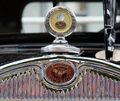
Bantam

American Bantam

In 1935, Roy Evans, a former salesman for Austin, bought out the bankrupt company, which was reorganized under the name American Bantam.
The formal connection with UK Austin was severed, though a relationship was maintained. A series of changes was made to the American Austin car design, including a modified engine, and an exterior sheetmetal designed by Alexis de Sakhnoffsky.
Production was resumed in 1937, and continued through 1941. Despite a wide range of Bantam body styles, ranging from light trucks to woodie station wagons, only about 6,000 Bantams of all types were produced.
American Bantam's 1938 model was the inspiration for Donald Duck's car which was first seen in Don Donald (1937).
The Jeep prototypes and the dissolution of the company

American Bantam is credited with the design of the first Jeep by Karl Probst, , and built 2675 of these. More than half of the initial production went to the British Army (and some to the Soviet Union) . Some of the motors and chassis were imported from Toledo, Ohio; the original bodies were made at the American Bantam Car factory in Butler, Pennsylvania.
The Bantam company produced the most fuel-efficient engine and first prototype under the original US government tender specifications and was awarded the first contract, but because Willys Overland used a more powerful engine, and because elements favorable to Ford within the Quartermaster Corps claimed that Bantam lacked production capacity to produce the vehicle on the scale needed by the United States Department of War, the awarding of ongoing contracts was reopened. Eventually the U.S. Army gave the BRC (Bantam Reconnaissance Car) 40 designs to Willys-Overland and awarded the bulk of orders to Willys and Ford, while Bantam went on to produce Jeep trailers (T-3).
After Jeep production stopped, Bantam made two-wheel trailers. This continued until the company was taken over by American Rolling Mills in 1956.
Gallery
-

Another view of the 1939 American Bantam
-

Bantam Model 60 Coupé 1938
-

Bantam Model 60 Roadster 1938
-

Bantam Model 60 Convertible 1939
-

American Bantam Model 60 Speedster Convertible 1939
-

An American Austin hood ornament
-

1940 American Bantam engine and transmission
No models found







